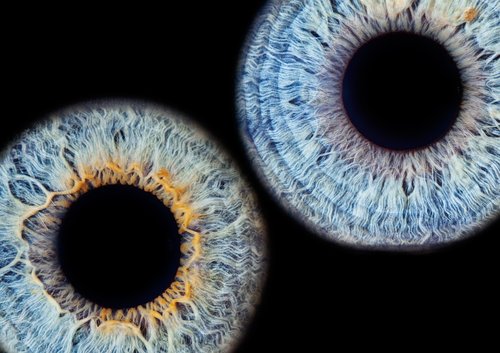Your eyes don't lie
It is said that our eyes reflect our emotions. Hippocrates, 4 Centuries BC, was already claiming “such are the eyes, such is the body”, but what does it mean?
In the 19th Century, the Hungarian doctor and homeopath called Ignaz Von Peczely, aged 11, was walking in the woods and got attacked by an owl who was afraid of the day light. While trying to escape, Ignaz broke one of the bird’s legs. Sad, he took the owl home with him to try to heal it. He then noticed a mark on the iris of the animal, on the same side as the broken leg, and started to wonder whether this mark could be linked to the injured leg. After years of research and practice, Ignaz Von Peczely confirmed his theory, published his work and became the father of modern Iridology.
Later, in the 20th Century, the Iridologic technique rapidly spread to Europe, the US and India.
In France, Léon Vannier, André Roux and Gilbert Jausas are considered masters in this field. These doctors and naturopaths spent years studying iris’ in order to sharpen the iris cartography and topography.
Other famous pioneers of iridology are Nils Liljequist (Sweden), Pastor Felke, Rudolph Schnabel and Joseph Deck (Germany) and Henry Lahn, Dr Henry Lindlahr, Dr Bernard Jensen and Dr John R. Christopher (US).
So, what is Iridology?
It’s a modern technique of observation and analysis of the iris used in Naturopathy, with the aim of obtaining supplementary information about someone’s health. It’s a holistic technique that allows one to access an overview of the body’s status. It’s not a method to diagnose illnesses but more a tool that a Naturopath can use to discern the assets and the weaknesses of an individual’s organs, to understand how their body works, and to evaluate their level of health and vitality.
Using a magnifying glass and a pocket lamp (raking light) or an iriscope (a device similar to a microscope, used for taking high resolution pictures), the Naturopath can reveal all the details of the iris: blemishes, shapes, pupil, pigmentations and colours, relief, quality of the iris thread and its modifications. The details are very subtle. The location of each mark gives some information about each organ of the body, which enables the practitioner to advice their client about beneficial lifestyle changes.
The irises, seen from very close, are absolutely stunning! All of these colourful marks look like beads from a kaleidoscope - beads that reveal some fascinating secrets! As for the pupils; on top of a physical reading, they also reveal psychological clues, which I find astonishing. When working to become a qualified Naturopath, I completed my iridology training with a case study. I was nervous about telling a poor stranger a load of nonsense and making her worry! However, as the observation and the conversation went by, I was able to ‘read’ some very intimate information in her eyes, although I had only met her for the first time! She confirmed it all, she was amazed (so was I!), and I’ll never forget that young woman who confided in me, through her eyes!
Thanks to Iridology, we can get an overview of how the body functions, and we can assess:
- the state of the Nervous System and the Endocrinal System;
- amounts of underlying stress;
- strengths, weaknesses, energy, vitamins and minerals deficiencies;
- levels of physical, psychological and immunological resistance;
- potential imbalances between acid and alkali in the body (which can lead to many common illnesses);
- amount of toxins in the body;
- different types of toxins clogging the organism (called toxaemia);
- the location of toxaemia and the ability of the emunctory organs to eliminate it;
- the person’s vitality resources;
- the person’s biological age;
- Hereditary tendencies.
I’ll stop there as it’s already a lot.
How can the iris provide so much information?
The iris is made of a membrane that contains smooth fibers to tighten up the pupil. The movements from the iris diaphragm are directed by a muscle called the ‘iris sphincter’. The iris also contains radiating fibers, which dilate the pupil, and a pigmentary membrane (called the ‘uvea’ in case you need it for your summer crosswords) which gives the iris its colour. The iris surface is very rarely smooth and most of the time shows some asperities and depressions. Its hue is never uniform. It has marks varying in shapes and colours. Iridology studies the iris surface and its irregularities, linking them to possible damage in different organs of the body.
The information given by the iris can have many origins. On one hand it’s a process of nervous transmission, like other systems of reflexology, and on the other hand a transmission through the blood, as the iris is largely vascular.
Each part or area of the iris is connected to an organ or a part of our organism. We can observe the command of the nervous system on iris sphincter, stimulating the movements of the pupil (constriction or dilatation). In terms of weakening or organic lesion, these are the constant micro-signals, sent by the weak organ, that allow the iris thread to show its characteristic and to be modified in the long term. The iris transmits the information from the organ from the very first signals, even before the illness establishes itself or any pain felt; which is why iridology is considered a preventative method.
A few anecdotes …
- ‘True’ brown eyes are not found so easily! If you look closely enough, you will notice that some eyes that we thought were brown are actually green or blue, covered with a layer of brown hue.
- We tend to find some colours of eyes prettier than others; when we actually know what these colours represent, we may change our minds! J
- Some iridologists believe that the left eye is connected to the past of the person (including inheritance), and the right eye to the present and future. This is valid for a right-handed person. The opposite will apply to a left-handed person.
- When marks appear on the iris, they generally remain there for life.
- We can start analysing the irises from children around 7 years old. Before that, the signs are not sufficiently established to allow examination.
How about your eyes? What do they have to reveal?
Using your camera (even on your phone, and not having a flash go off directly in your eye), have a go and take a picture of your iris’ and send them to me! If the quality is good enough, I will send you a short analysis! Send me those as usual via the contact form on my website or to soakupthewild@gmail.com.
I’m looking forward to diving into your wonderful eyes!

